
How New Forms of Human Augmentation Could Affect Our Brains
Clip: Episode 4 | 9m 9sVideo has Closed Captions
Ari tries a “third thumb” and explores how new tech is reshaping our idea of being human.
A rapidly changing modern world, with its technological advancements and pressing global issues, challenges traditional notions of what it means to be human. Designer Dani Clode shows Ari her third thumb invention and discusses how human augmentation raises questions about how these technologies will reshape our understanding of humanity.
Supported by the Hoveida Family Foundation and The Rosalind P. Walter Foundation.

How New Forms of Human Augmentation Could Affect Our Brains
Clip: Episode 4 | 9m 9sVideo has Closed Captions
A rapidly changing modern world, with its technological advancements and pressing global issues, challenges traditional notions of what it means to be human. Designer Dani Clode shows Ari her third thumb invention and discusses how human augmentation raises questions about how these technologies will reshape our understanding of humanity.
How to Watch A Brief History of the Future
A Brief History of the Future is available to stream on pbs.org and the free PBS App, available on iPhone, Apple TV, Android TV, Android smartphones, Amazon Fire TV, Amazon Fire Tablet, Roku, Samsung Smart TV, and Vizio.
Buy Now

What It Means to Be Human
A Brief History of the Future explores the human ability to increase empathy and compassion, what values we are instilling into artificial intelligence technologies, and the need to create both a better world and a better humanity for life to flourish on this planet.Providing Support for PBS.org
Learn Moreabout PBS online sponsorship- We're struggling with right now is trying to retrieve what it means to be human in a digital age.
We know something's wrong.
- The story you're going to see and hear is about science.
It is also a story about you.
♪ ♪ - One interesting question to ask right now-- what does it mean to be human?
And I think it's good to ask that question because what it meant to be human may be different going forward.
♪ ♪ - Back when I was a little hacker kid, there was something we called an exploit.
And that was, when you were hacking, you would find an exploit in the computer so that you could get in there and, like, control the thermostat at the mall, right?
Or change your grades in school.
What we're doing now is telling our computers and digital technologies and AIs and algorithms to find exploits in us-- exploits in our psychology, exploits in our emotional fabric, exploits in our neurology-- and to mine them for whatever purposes they deem are important to them.
So when we are living in a landscape increasingly populated by entities that are trying to exploit us, to destabilize us, to decalibrate our neurology and psychology, we are going to end up emotionally unstable and cognitively compromised.
♪ ♪ - There are startups.
There are established companies that are working very hard right now to bring machines and humans together in new ways.
We have tools that could transform humanity.
And we need to really think through how we're gonna deploy them.
[tense music] - These new tools are fascinating and full of incredible potential to improve our lives.
But they also raise all sorts of questions about the impacts and unintended consequences they will bring.
What does it mean to add on to our biology?
And what are the implications to who and what we are?
I've come to Cambridge University, where an augmentation designer named Dani Clode is working on a project called the Third Thumb, a 3D-printed hand extension controlled by the feet exploring the impacts of body-connected technology.
♪ ♪ - So this is my thumb.
So this is controlled with my toes.
So there's pressure sensors underneath my big toes.
And I'm controlling the two degrees of freedom.
It seems kind of bizarre to be controlling something on my hand with my toes.
But there's also so many products that already utilize this really strong connection between our upper and lower limbs.
And often it's to extend the task that our hands are doing.
Driving is the main one.
Instruments, sewing machines.
It's very frequent that we'll kind of, you know, lean on the toes to extend the function of the hands.
- It does freak me out a little bit.
- Yeah, does it?
It's a normal first response.
- Is it?
Is it?
I mean, what is that coming-- like, deep down, what is it that folks are responding to when they see--it's one thing to talk about something like this theoretically.
It's another thing to be talking to another human with six fingers.
- It's really important that I find that line and don't try to cross it too much in terms of the weirdness.
Because I want it to be accepted.
You know, I want it to be something that people are intrigued about trying on.
Hesitant, but intrigued is my sweet spot.
And so not scared.
So yeah.
So this is what is going underneath your foot.
The main control is the dominant kind of flexion control.
And it sits just on your palm there.
So we usually do-- so the dominant movement, which is flexion/extension of our thumb.
So this is flexion, extension, and adduction and abduction.
So that's where the two degrees of freedom of the thumb that I focus on.
- I want to see if I can-- - Yeah.
You're doing good for your first kind of minute.
[laughs] What you can probably notice is that straight away, it's quite easy to do the big, full movements really quickly.
And then it's what you start to learn across the week if you are a participant is there's really smaller, finer motor movements.
And that's when kind of calibrating the sensors to your feet and stuff would really help.
It's already changing the way that you are considering approaching an object.
Yeah.
There we go.
[laughs] - Have to keep the pressure on it.
- Yeah.
- I mean, but just-- I mean, look, I'm a minute into it.
But then the ability to-- - Yeah.
There we go.
- I'm not as scared anymore.
- [laughs] I'm so glad.
[music playing] - Dani's project is designed to be a fun and thought-provoking experience.
But it sits inside of a rapidly-accelerating new field known as human augmentation, where designers around the world are working on ways to increase and expand our bodies' natural capacities.
And as simple as it seems to play with a third thumb, what she is really doing is using this as a way to learn about how our brains respond to tools outside our biological bodies.
How does this change the definition of human?
Because when we often think of the term human... - Yeah.
- We think of... the very kind of classic Homo sapien hardware set.
But you're talking about something dramatically different.
- Yeah.
- How will that change how we think about what it means to be human?
- I mean, I think we're already playing around with what it means to be human.
We're adapting ourselves already so much technologically, you know?
And even something as, like, simple and complex as memory with our phones, you know, we've already changing the way, you know, we utilize our memory.
I don't know if you can remember phone numbers.
But I used to remember all my best friends' phone numbers.
And now, I can barely remember my own.
We're already shifting ourselves so much.
And so when you start to change the way we embody this technology that's implanted or removable or wearable, the human is gonna not stop at the skin level.
- What we're talking about isn't slowing down.
It's just speeding up.
What are the questions that you're asking yourself about where this might go, where this should go, where this could go?
- I'm so excited for how much it's gonna help people.
But we also just have to-- I feel like we just have to move at this equal pace of questioning it constantly.
And I feel like a lot of people that are developing this kind of technology aren't really truly thinking about the impact on our biological selves.
Because it's technology, right?
So we're just kind of like, go, go, go, go, go as fast as possible.
And make it efficient, make it--you know?
And where ability is even not included as much, let's just make it work.
And then we'll work out everything else later.
And so we really just need to be cautious of that.
- What's striking about this field is how little is currently known about how our brains will respond to these new tools.
And that's what Dani is calling for, a lot more study into the effects and consequences as new products and designs continue to roll out.
While I was there, she let me take part in an MRI-based study designed to measure the brain's response to this kind of augmentation.
As participants follow simple prompts to move the third thumb, generating valuable data that she and her team can analyze.
- We're just about to start, yeah?
You ready?
- I'm ready.
- Just touch the fingers.
So the thumb and the other fingers together.
Like one, yeah.
Okay.
- Yeah.
I can already see that.
- Okay.
We stop now.
- This is amazing, because it's my brain.
- It is your brain.
- What is it that you're curious about?
- Well, we want to see the impact potentially that upper limb augmentation is having on your brain.
And we have to do MRI to really investigate that.
- In many ways, what took hundreds of thousands of years or maybe even millions of years of evolution to give us these, you know, 10 fingers and 10 toes, you're now doing in a matter of a couple of years.
- Yeah, I mean, we're not sure what a couple of years using augmentation devices would do to the brain.
At the moment, we're running a seven-day training study, which is already a lot of data collection.
So yeah.
I mean, but this is technology that could potentially be used for years.
We need to see the impact that it's having on the brain to try and investigate what's changing.
- The research Dani is doing is fascinating and feels more important than ever as we look ahead.
Augmentation is only the tip of the spear in terms of the scientific transformation we are in the midst of.
How AI is Transforming How We Create and Engage with Art
Video has Closed Captions
Ari explores the powerful potential of AI to transform how we create art going forward. (8m 1s)
Providing Support for PBS.org
Learn Moreabout PBS online sponsorshipSupported by the Hoveida Family Foundation and The Rosalind P. Walter Foundation.
















